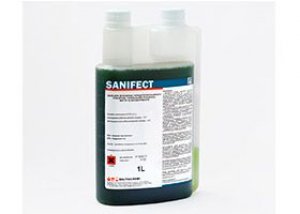
All iLive content is medically reviewed or fact checked to ensure as much factual accuracy as possible.
We have strict sourcing guidelines and only link to reputable media sites, academic research institutions and, whenever possible, medically peer reviewed studies. Note that the numbers in parentheses ([1], [2], etc.) are clickable links to these studies.
If you feel that any of our content is inaccurate, out-of-date, or otherwise questionable, please select it and press Ctrl + Enter.
Sanifect
Medical expert of the article
Last reviewed: 03.07.2025

ATC classification
Active ingredients
Pharmacological group
Pharmachologic effect
Indications Sanifect
Indications for use of the product are the following cases:
- disinfection of medical instruments (including endoscopes (flexible or rigid) and their complementary components), various medical equipment, and devices. In addition, for laboratory instruments and utensils, furniture and various indoor surfaces, equipment with sanitary and technical purposes. Also for utensils and linen, and in addition to this, items for caring for patients with infections of various origins - bacterial (including tuberculosis), viral (HIV and hepatitis), and fungal (such as candidiasis or dermatophytes). Along with this, it is also used in various medical and preventive facilities (these are biochemical, as well as virus and bacteriological laboratories, donor transplant or blood transfusion centers, and in addition to this, pathology departments, etc.), educational or child care institutions, residential apartments, etc.;
- disinfection, as well as pre-sterilization cleaning of manicure, hairdressing, and cosmetology instruments, disinfection of ultrasound device heads, and connecting hoses in anesthesia and respiratory mechanisms;
- disinfection of instruments used in surgery, dentistry, obstetrics and gynecology procedures, etc.;
- General cleaning, as well as preventive disinfection in pharmacies, as well as in various industrial enterprises (perfumery-cosmetology, pharmaceuticals, food). Also in sanatoriums or boarding houses, as well as other health centers (departments of balneological procedures, physiotherapy, functional diagnostics procedures), on rolling stock facilities (public and rail transport), in ambulances. In addition, in public places (hotels, train stations, hostels, retail outlets, cinemas, catering buildings, banks, communications enterprises, saunas, baths and swimming pools, as well as public toilets), in training and competition centers, etc.;
- disinfection at epidemiologically significant facilities of other production departments, as well as institutions from the service sector, whose functions require the performance of such work - to comply with sanitary and hygienic standards and anti-epidemic rules in accordance with regulatory and methodological documentation.
Release form
It is produced in the form of a disinfectant solution.
Pharmacodynamics
The medicine has antimicrobial properties and affects a large number of pathogenic microbes: gram-positive and gram-negative bacteria (including those that cause cholera or tuberculosis), viruses (herpes, flu, adenoviruses, hepatitis types A, B, and C, as well as HIV, polio and enteroviruses), mold fungi and Candida fungi, as well as trichophyton. Solutions of this type also have a deodorizing and washing effect. When the temperature rises to 50 ° C, their antimicrobial properties and washing effect are enhanced.
Dosing and administration
Disinfection with Sanifect is performed by irrigation, wiping, and soaking or immersion in the solution. The product, ready for treatment, should have room or elevated temperature - 50°C.
To disinfect medical instruments, they should be completely immersed in a container with a pre-added solution. The channels and cavities of the devices should be filled with an antiseptic agent using a pipette or syringe (while removing air from there). Products that can be disassembled are disinfected in this form. After the procedure, the instruments must be washed from the remains of the solution (use running water for about 5 minutes; or immerse them in a container filled with water for 10 minutes, then take them out and rinse under the tap for half a minute).
Manicure, hairdressing and cosmetology devices are processed using the above method.
Medical equipment and devices, as well as furniture and walls with floors, should be wiped with a rag, which should be soaked in the solution (dilute the product in a ratio of 100 ml per 1 m2 ), or these surfaces should be sprayed (dilute in a ratio of 250-300 ml per 1 m2 ).
The dishes should be cleared of food residues and completely immersed in the solution (for one set (small and deep plates, saucer with cup, knife, fork, tablespoon and teaspoon) 2 liters of solution are required). After completing the procedure, rinse the treated dishes under water (about 3 minutes).
The laundry should be soaked in liquid (the solution is diluted in a proportion of 4 liters per 1 kg of laundry (in dry form)). Soaking makes subsequent washing easier, as well as removes various persistent general stains (such as discharge, blood, etc.). After processing, the laundry should be washed and rinsed.
Items required for patient care must be completely immersed in the solution and rinsed under water (3 minutes) after the procedure.
Plumbing equipment should be wiped with a rag soaked in the solution, cleaned with a brush, or sprayed.
Manufacturer
Attention!
To simplify the perception of information, this instruction for use of the drug "Sanifect" translated and presented in a special form on the basis of the official instructions for medical use of the drug. Before use read the annotation that came directly to medicines.
Description provided for informational purposes and is not a guide to self-healing. The need for this drug, the purpose of the treatment regimen, methods and dose of the drug is determined solely by the attending physician. Self-medication is dangerous for your health.


 [
[